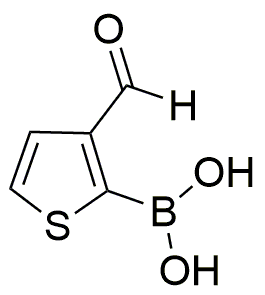3-Formyl-2-thiopheneboronic acid is widely utilized in research focused on:
- Organic Synthesis: This compound serves as a versatile building block in the synthesis of various organic molecules, particularly in the development of pharmaceuticals and agrochemicals.
- Medicinal Chemistry: It plays a crucial role in the design of novel therapeutic agents, especially in targeting specific biological pathways due to its unique boronic acid functionality.
- Material Science: The compound is used in the fabrication of advanced materials, including conductive polymers and organic semiconductors, enhancing the performance of electronic devices.
- Chemical Sensors: Its properties make it suitable for developing sensors that detect specific biomolecules, which is valuable in medical diagnostics and environmental monitoring.
- Cross-Coupling Reactions: It is effective in palladium-catalyzed cross-coupling reactions, facilitating the formation of carbon-carbon bonds, which is essential in creating complex molecular architectures.
General Information
Properties
Safety and Regulations
Applications
3-Formyl-2-thiopheneboronic acid is widely utilized in research focused on:
- Organic Synthesis: This compound serves as a versatile building block in the synthesis of various organic molecules, particularly in the development of pharmaceuticals and agrochemicals.
- Medicinal Chemistry: It plays a crucial role in the design of novel therapeutic agents, especially in targeting specific biological pathways due to its unique boronic acid functionality.
- Material Science: The compound is used in the fabrication of advanced materials, including conductive polymers and organic semiconductors, enhancing the performance of electronic devices.
- Chemical Sensors: Its properties make it suitable for developing sensors that detect specific biomolecules, which is valuable in medical diagnostics and environmental monitoring.
- Cross-Coupling Reactions: It is effective in palladium-catalyzed cross-coupling reactions, facilitating the formation of carbon-carbon bonds, which is essential in creating complex molecular architectures.
Documents
Safety Data Sheets (SDS)
The SDS provides comprehensive safety information on handling, storage, and disposal of the product.
Product Specification (PS)
The PS provides a comprehensive breakdown of the product’s properties, including chemical composition, physical state, purity, and storage requirements. It also details acceptable quality ranges and the product's intended applications.
Certificates of Analysis (COA)
Search for Certificates of Analysis (COA) by entering the products Lot Number. Lot and Batch Numbers can be found on a product’s label following the words ‘Lot’ or ‘Batch’.
Número de catálogo
Número de lote/lote
Certificates Of Origin (COO)
This COO confirms the country where the product was manufactured, and also details the materials and components used in it and whether it is derived from natural, synthetic, or other specific sources. This certificate may be required for customs, trade, and regulatory compliance.
Número de catálogo
Número de lote/lote
Safety Data Sheets (SDS)
The SDS provides comprehensive safety information on handling, storage, and disposal of the product.
DownloadProduct Specification (PS)
The PS provides a comprehensive breakdown of the product’s properties, including chemical composition, physical state, purity, and storage requirements. It also details acceptable quality ranges and the product's intended applications.
DownloadCertificates of Analysis (COA)
Search for Certificates of Analysis (COA) by entering the products Lot Number. Lot and Batch Numbers can be found on a product’s label following the words ‘Lot’ or ‘Batch’.
Número de catálogo
Número de lote/lote
Certificates Of Origin (COO)
This COO confirms the country where the product was manufactured, and also details the materials and components used in it and whether it is derived from natural, synthetic, or other specific sources. This certificate may be required for customs, trade, and regulatory compliance.


